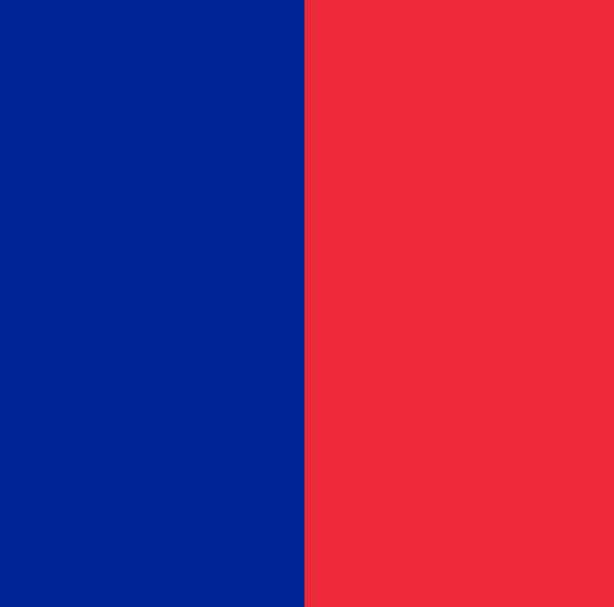The French flag is an iconic symbol of France’s culture and history. A potent emblem of revolution, the twisting saga behind the French flag is more than a curiosity for vexillologists. We dive into stories behind the Tricolore to discover how the humble design inspired so many.

French flag colors meaning
What are the meanings of the colors of the French flag? In a nutshell, the white in the center of the flag represents the former monarch which no longer exists. The red and the blue represent the city of Paris and also comprise the colors of Paris’ flag (see below).
French flag history
It can’t be easy to conceive a design that projects a nation’s heritage, and most national flags boast a compelling backstory.
This is certainly true of the deceptively simple drapeau Français, a flag loaded with cultural symbolism that would inspire many imitators. Notably in Italy and Ireland, countries with their own revolutionary legacies.
Inspired by the cockades of French revolutionaries, its design encapsulates the dreams and aspirations of an era-defining event.
As it happened, the design chose itself. Or rather, the people decided.
After briefly flirting with a green rosette, rebellious militia settled on a symbol representing the cauldron of the revolution: Paris. The city’s historic flag consisted of single red and blue stripes.

A white stripe completed the French Tricolore. And it’s the most unexpected of the French flag colors. White represents a monarchy that would have preferred to keep the old flag.
The addition of the monarchy’s historic white banner was all a matter of timing. The French Revolution began on July 14, 1789. The new flag was approved on October 24, 1789, just 3 months after the Storming of the Bastille. It was soon seen flying on French naval vessels.
At the time, Louis XVI was still nominally head of state, harboring illusions of a comeback. When presented with the new flag, he insisted on representation.
The white stripe was added to underline how the monarchy would still play a diminished role in the new Republic.
Louis’s role couldn’t get more diminished than when he and Marie Antoinette lost their heads in 1793. Despite the flag being updated in 1794, the monarchy’s white remained.
In 1794, the tricolor order was reversed, setting the in stone the official French flag colors of blue-white-red.
Through several Royal revivals and a smattering of revolutions, the French Tricolore survived to the current Fifth Republic. But not without some intriguing diversions along the way.
The French Flag of the Bourbon Restoration
Illustrating how you can’t keep a good revolution down in France, the Bourbon Restoration in 1814 saw a new flag flying above Versailles (see below).
The new monarch Louis XVIII (Louis XIV’s brother) was less than enthusiastic about reminders of the French Revolution, promptly transforming the Tricolore into a unicolor.
The white representing the monarchy remained, surprising nobody. Although the king claimed the design revived the pre-Revolutionary naval flag, which was all-white. Overlaying the plain background was a royal coat of arms.
The new Bourbon standard was as doomed as the rule of Charles X, Louis XVIII’s successor. After Charles abdicated in 1830, the familiar French flag colors returned for good under Louis Philippe I.
French flags in WWII
World War II introduced citizens to two new versions of the French Tricolore as the country split following the Nazi invasion. First came the personal standard of Phillipe Pétain, the head of Vichy France. A once-feted Marshall of France, his standard bore a Marshall’s baton and stars.
Meanwhile, bitterly opposed citizens in the Free French Army flew a flag carrying the Cross of Lorraine in the center, symbolic of France’s armed conflict with Germany.

Presidential Changes to the French Tricolore
War wasn’t the only time the national flag of France got a makeover. Bored presidents also tinkered with the design.
Most recently, the color-conscious President Emmanuel Macron officially restyled the Tricolore with a dark navy blue. Not to match his suits, but reportedly because it clashed with the EU flag at events.
It’s a plausible explanation, as the initial change by President Giscard d’Estaing lightened the blue as a pro-European gesture in 1976.
The French flag of the Second Republic
Even more needless than the changes made by hair-splitting presidents was the briefly lived French Tricolor of the Second Republic. The Second Republic of 1848 to 1852, a revolutionary sequel deposing another king, came up with the brilliant idea of rearranging the tricolor order. Again.
The Second Republic’s blue-red-white did not last long. Introduced on February 24, 1848, the design was binned just 9 days later. Future republics will be happy to know that several color combinations haven’t been tried.

Pre-revolutionary French flags
The elegant design of the people-inspired flag sent another message: the excesses and extravagance of monarchical France were over.
This is another reason it looked so different from the pre-revolutionary Kingdom of France flag. Multiple historical French flags came before the Tricolore, most featuring distinctive gold fleurs-de-lis on a white or blue background.
The House of Bourbon was flying over Versailles when the French Revolution erupted. Their dynastic standard featured three fleurs-de-lis in a V formation on a blue background. Preceding dynasties, like the Capetians, had similar flags, almost always displaying fleurs-de-lis symbols.
Today, you can see vestiges of that legacy in the state flags of Quebec and New Orleans (see below).
Flag of the House of Bourbon

Flag of Quebec

New Orleans flag

French flag emoji
A contemporary footnote in the history of the Tricolore is the modern French flag emoji. This comes in very handy for vacationers in Paris or when the national football team plays.
But look closer at your phone, as yours might be outdated: some platforms don’t display the President Macron-approved navy blue stripe design. This is worth noting if you want to include a flag emoji when texting about France.
For most phones, simply type the word “France” or “French” and the emoji will appear.


